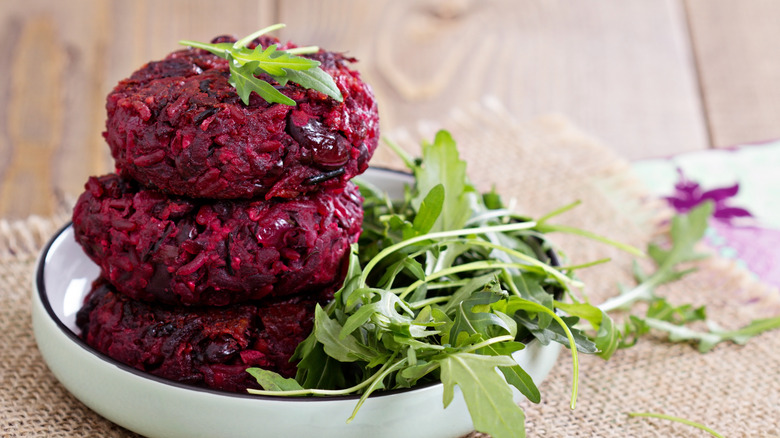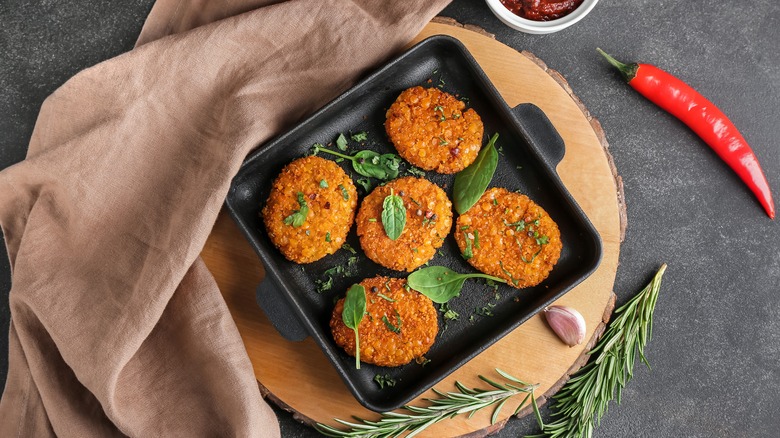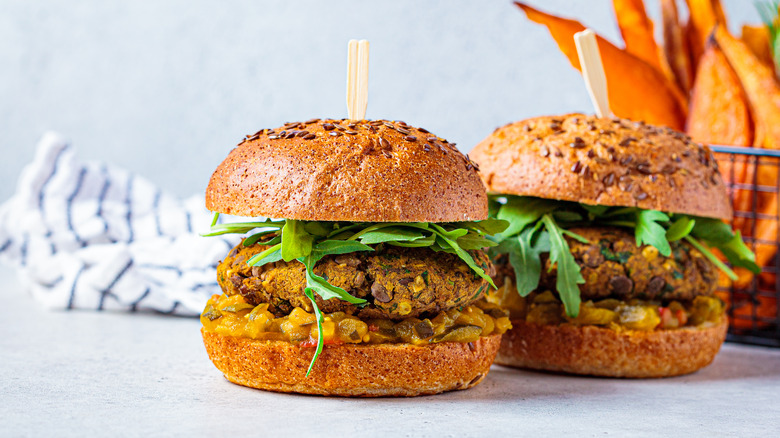The Common Mistake To Avoid When Adding Rice To Your Veggie Burgers
Since gaining traction in the '80s, veggie burgers have come a long way in style and ingredients. Certain inclusions are a main-stay when forming veggie burgers, due to the structure and texture they award the patty. Whole grains like brown rice and quinoa have both become popular as the needed binding ingredient. (This veggie burger tip is even endorsed by Guy Fieri.) However, if you're inclined to whip some up in this fashion, there's one common pitfall you'll want to avoid.
Namely, ensure the rice, or any whole grain, is cooked before adding it to the other burger ingredients. Ideally, a veggie burger containing rice is tenderly textured; it should not have the crunchy, bitter bite of raw or undercooked rice. Even if you're planning to grill these patties, there is not enough time for the heat to cook the rice inside the patty. There's also the additional concern that raw rice would not bind the other ingredients — in other words, it may break the patty apart instead of holding it together.
Not only does using raw rice impact the taste and form of your patty, but consuming raw or undercooked rice can become a health hazard. Now, let's delve into the best way to prepare rice for veggie burgers, and other grains you may wish to consider.
A brief guide to rice in veggie burgers
Different types of rice require different cooking times, but for veggie burgers, there's a sweet spot. In this instance, it's best to cook the rice until it's just reached the tender spot, and is not overcooked. If there's still water in the pot, drain well and pat down the rice to remove excess moisture. Before mixing, it's best to ensure the rice has cooled. Cool rice is stickier than hot, allowing you to form solid patties that hold their shape once cooked. Additionally, if you're using an egg to further bind the ingredients together, hot rice may start to cook the egg prematurely.
It's also important to consider the type of rice you will use. Long-grain brown rice does not contain as much starch as short-grain brown rice, so it lacks a certain stickiness that's perfect for helping veggie burgers stay together. Another variety that would equally work well is the renowned sticky glutinous rice, which would provide a satisfyingly chewy bite.
Once the rice is in check, you'll realize how versatile these patties can become. Mixing umami ingredients like cooked mushrooms, soy sauce, and rice vinegar will work deliciously well. Equally, a warmly spiced sweet potato mixture that's filled with black beans, garlic, paprika, and cumin provides another tasty patty.
A note on other grains for veggie burgers
If rice isn't high on your list of veggie burger ingredients, there are other ways to get a nicely textured patty. Lentils, a grain legume, are a great addition to veggie burgers as they build structure and are naturally rich in protein. They also have a neutral flavor that can easily be imprinted with other aromas (such as spices, tomatoes, garlic, and carrots). Like rice, it's best to cook dry lentils first or use canned ones. If you are cooking the lentils yourself, they mustn't be overcooked or mushy to ensure the best texture for your burgers.
Quinoa must also be precooked before being added to your veggie burger mix. This grain would wonderfully complement a burger packed with the sunshine flavors of the Mediterranean, like sun-dried tomatoes, fresh basil, and salty feta. For the best-tasting quinoa, it's advised to soak it first for a minimum of 2 hours, as this will reduce the acid content of the grain. It can then be boiled in 1½ cups of water for every 1 cup of quinoa. Remember, you want to retain that bite and structure.
Next time you prepare veggie burgers with rice or other grains, be sure to follow this precooking tip. It will improve the texture, shape, and taste.


